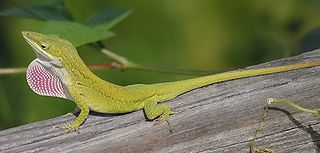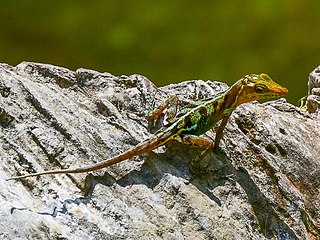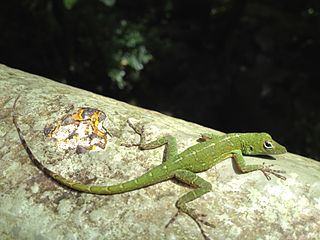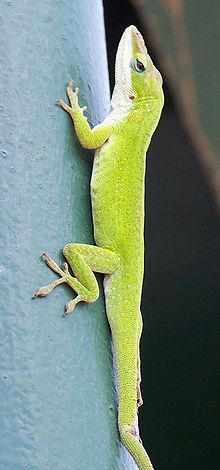
In evolutionary biology, adaptive radiation is a process in which organisms diversify rapidly from an ancestral species into a multitude of new forms, particularly when a change in the environment makes new resources available, alters biotic interactions or opens new environmental niches. Starting with a single ancestor, this process results in the speciation and phenotypic adaptation of an array of species exhibiting different morphological and physiological traits. The prototypical example of adaptive radiation is finch speciation on the Galapagos, but examples are known from around the world.

Dactyloidae are a family of lizards commonly known as anoles and native to warmer parts of the Americas, ranging from southeastern United States to Paraguay. Instead of treating it as a family, some authorities prefer to treat it as a subfamily, Dactyloinae, of the family Iguanidae. In the past they were included in the family Polychrotidae together with Polychrus, but the latter genus is not closely related to the true anoles.

Anolis carolinensis or green anole is a tree-dwelling species of anole lizard native to the southeastern United States and introduced to islands in the Pacific and Caribbean. A small to medium-sized lizard, the green anole is a trunk-crown ecomorph and can change its color to several shades from brown to green.

The brown anole, also known commonly as the Cuban brown anole, or De la Sagra's anole, is a species of lizard in the family Dactyloidae. The species is native to Cuba and the Bahamas. It has been widely introduced elsewhere, via the importation and exportation of plants where the anole would lay eggs in the soil of the pots, and is now found in Florida and other regions of the United States including southern Georgia, Texas, Louisiana, Tennessee, Mississippi, Alabama, Hawaii, and Southern California. It has also been introduced to other Caribbean islands, Mexico, and Taiwan.

The knight anole is the largest species of anole in the Dactyloidae family. Other common names include Cuban knight anole or Cuban giant anole, highlighting its native country, but it has also been introduced to Florida. In its native Cuba, this large anole is called chupacocote.

Anolis pulchellus, the Puerto Rican anole, Puerto Rican bush anole, snake anole, or sharp-mouthed lizard, is a small species of anole lizard in the family Dactyloidae. The species is among the most common lizards in Puerto Rico, and also native to Vieques, Culebra, and the Virgin Islands.

Anolis cristatellus is a small species of anole, belonging to the Dactyloidae family of reptiles. The species is native to Puerto Rico and the U.S. and British Virgin Islands, with introduced populations in locations around the Caribbean. The males of A. cristatellus are easily recognizable by the fin running down the top of the tail, which is known as a "caudal crest". The females also have this crest, but it is smaller than that of the males. The species is often quite common in many areas on Puerto Rico, where it can be seen during the day passing the time on the lower parts of tree trunks, or on fences and the walls of buildings in urban areas, sometimes venturing down onto the ground in order to lay eggs, have a snack, or do other cursorial activities. Like many anoles, this species displays the characteristic behaviour of doing push-ups as well as inflating a pizza-like flap of coloured skin on its throat, known as a dewlap, in order to show others how dominant it is, and thus attract mates or intimidate rivals.

Anolis allisoni, also known commonly as Allison's anole or Cuban blue anole is a species of lizard in the family Dactyloidae. The species is endemic to Cuba, the Bay Islands and Cayos Cochinos off the mainland of Honduras, and Half Moon Caye off the mainland of Belize. There is also a single doubtful record from Cozumel, Mexico. Recently, the species has been documented in southern Florida. This diurnal species is commonly seen on palm trunks, and it feeds on invertebrates. It is among the relatively few anole species in which females may lay their eggs together, forming a communal nest.

Anolis barbatus is a species of anole lizard from Western Cuba. Adults have a typical snout–vent length of about 18 cm (7 in), with tails that are slightly shorter than their bodies, and demonstrate little sexual dimorphism. It is one of six species called "false chameleons" that sometimes are recognized as their own genus Chamaeleolis or as the Cuban clade in Xiphosurus. These are all native to Cuba, fairly large for anoles, have robust heads, are dull gray-brown in color, slow-moving and have blunt teeth used for crushing snails, which is their main diet in the wild. Unusually among anoles, these all lack the ability to autotomize their tails. Together with the similar, but not closely related A. landestoyi of Hispaniola, they form a group known as the twig–giant ecomorph.

Anolis bartschi, also known commonly as the Pinar Del Rio cliff anole, western cliff anole, and the west Cuban anole, is a species of lizard in the family Dactyloidae. The species is endemic to Cuba.

Anolis grahami, commonly known as the Jamaican turquoise anole and Graham's anole, is a species of lizard in the family Dactyloidae. The species is native to the island of Jamaica, and has also been introduced to the territory of Bermuda. It is one of many different species of anole lizards found in Jamaica. There are two recognized subspecies.

The Anolis carolinensis series is a proposed clade or subgroup of closely related mid-sized trunk crown anoles within the genus Anolis. It was created by Nicholson et al. in 2012 and defined as containing 13 species, a few examples are listed below.

The ecomorph concept is a term first coined by Ernest Edward Williams in 1972 which he defined as a “species with the same structural habitat/niche, similar in morphology and behavior, but not necessarily close phyletically.” Williams first applied this definition to the Greater Antillean anoles upon observing their evolutionary radiation, although it has since been used widely elsewhere.

Anolis proboscis, commonly known as the horned anole, Ecuadorian horned anole or Pinocchio lizard, is a small anole lizard in the family Dactyloidae. A single male specimen was discovered in 1953 in Ecuador and formally described by Peters and Orces in 1956, but the species then went unreported until its rediscovery in 2004. Its currently known habitat is a small stretch of vegetation along an Ecuadorian highway. It has been classified as Endangered by the IUCN due to its restricted distribution and ongoing habitat loss.

Anolis lineatus, the Curaçao striped anole or striped anole, is a species of lizard in the family Dactyloidae. It is native to Curaçao and Aruba of the Netherlands Antilles, but has also been introduced to Klein Curaçao. It is generally common, and is particularly common in densely vegetated gardens in the capital Willemstad. It is found in dry tropical shrubland at all elevations in its range, but is uncommon in habitats without larger trees. It can often be seen on rocks, the walls of buildings or tree trunks; at various heights but often relatively close to the ground. It is a member of the A. chrysolepis species group.

Anolis vermiculatus, the Vinales anole or Cuban stream anole, is a species of lizard in the family Dactyloidae, endemic to Cuba.

Anolis aquaticus, commonly known as the water anole, is a semi-aquatic species of anole, a lizard in the family Dactyloidae, native to southwestern Costa Rica and far southwestern Panama. The species demonstrates adaptations that allows it to spend periods of time underwater up to approximately a quarter of an hour, forming an air bubble which clings to its head and serves to recycle the animal's air supply while it spends time beneath the surface. Although highly unusual, similar adaptions and behavior are found in other species of semi-aquatic anoles.

Anolis auratus, the grass anole, is a species of lizard in the family Dactyloidae. The species is found in Costa Rica, Panama, Venezuela, Colombia, French Guiana, Guyana, and Brazil.

Anolis evermanni, also known commonly as the emerald anole, Evermann's anole, and the small green anole, is a species of lizard included within the family Dactyloidae. A. evermanni is native to Puerto Rico, where it is mainly found in wet forests. A. evermanni is a medium-sized lizard and bright emerald-green in color. A. evermanni is studied for its behavior as well as the evolution of the family Dactyloidae. The group of lizards which are member species of the family Dactyloidae are known as anoles. Anoles are found throughout the Americas and are related to iguanas.

Anolis gundlachi, also commonly known as the yellow-chinned anole, Gundlach's anole, and the yellow-beard anole, is an oviparous, sexually dimorphic species of lizard in the family Dactyloidae. The species is endemic to Puerto Rico and lives in mountainous forests at high elevations. The diet of A. gundlachi consists mostly of insects. This species is also known for signaling other lizards through a modulated head bob display, with varying bobbing amplitudes and patterns based on an individual's distance from other lizards.





















